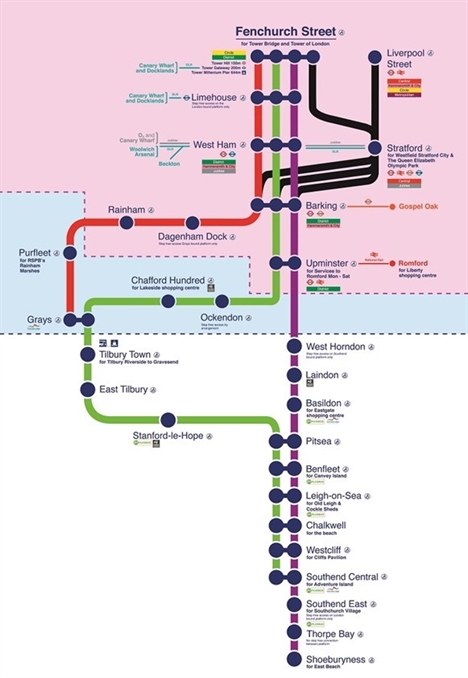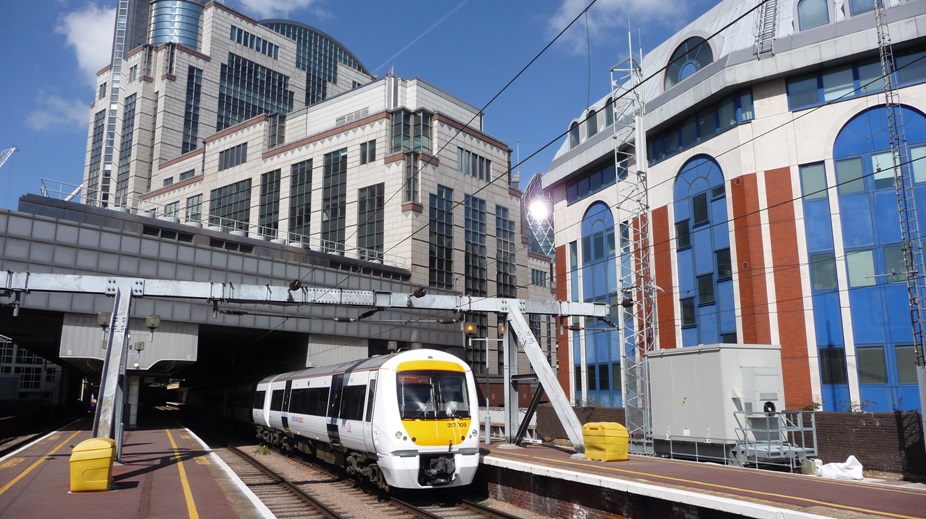01.03.15
Capital to coast, coast to capital, commitment to customers
Source: Rail Technology Magazine Feb/March 2015
c2c successfully retained the Essex Thameside franchise and has had a busy first 100 days. RTM spoke to managing director Julian Drury.
The second long-term franchise to be announced in the current wave of refranchising agreements was Essex Thameside. c2c – part of National Express Group – was told it had kept hold of the business in June 2014.
The new franchise started in November 2014, with some perks for passengers: free wi-fi at stations, discounted fares and a big push on the new Smartcard, which was used for more than 350,000 journeys in the first 100 days.
The most recent punctuality statistics, for January, put c2c at 97.4%, up from 96.2% in the same period last year – and right at the top of the pile, beating every other franchise and open access operator. Its moving annual average is also industry-leading, at 96.7%.
Some might say that c2c’s relatively simple routes – from London Fenchurch Street out to Southend and Shoeburyness, also incorporating the Tilbury Loop Line and Upminster to Grays – make good performance inevitable. Drury does not agree.
He told us: “I often hear people say ‘it’s easy because you’ve got a self-contained route and you don’t have any interaction with other operators’ – but if you are an operator, you know it’s not like that. Every train can be a problem, if you let it be a problem.
“We have a very detail-conscious approach to managing performance, and we are very close with Network Rail as well. We do a lot of diagnostic work, we do a lot of root-cause analysis, and there’s no magic bullet to improving performance: it’s all about patience, detail and working through one by one what the causes are and sorting them out.”
Overall, he suggested that c2c’s good performance figures are because of its own policies and hard work – not just because of an inherently simple route.

Line speed
The route itself is a constraint. Although c2c’s fleet of Class 357 Electrostars (built 1999-2002) are capable of 100mph, the London, Tilbury and Southend Railway has a maximum speed of 75mph. Average speeds are lower than this.
But line speed improvements are on the cards, according to Drury, as part of the formal alliance with Network Rail, which was originally signed in 2012 and renewed when the new franchise began.
He said: “[We will] look at the opportunities to increase the line speed on the route. We’ve identified five sections where there’s the potential to do that. That’s one of our actions for 2015 in the alliance.”
Network Rail spokeswoman Sam Kelly said: “Changes at Pitsea station will mean minor line speed improvements and we have aspirations to increases line speeds at Upney Junction, Cranham footcrossing, and Purfleet Rifle Range crossing. Plans are in early stages and proposals are being developed.”
Essex County Council has also urged that the line speed be raised to 100mph, and it was included in the ‘Once in a generation – A rail prospectus for East Anglia’ document as part of the long-term vision for the line to 2032.

New rolling stock
Performance is also aided by c2c’s standardised fleet, made up solely of Class 357s, split into two sub-fleets that are “more or less identical”.
Drury said: “In terms of operational flexibility, it’s the best possible situation to be in. Certainly in terms of maintenance, spares holding, maintenance knowledge, downtime, they can all be standardised. There are many reasons it’s good to have a single fleet type.”
As part of the new franchise, c2c will procure 17 new trains, though the tendering process hasn’t started yet. But with the major manufacturers all rolling out their next-generation platforms for rolling stock types, it may be that the Electrostar is no longer in production, even if Bombardier won the contract, as it shifts to the Aventra family. Other major manufacturers are also showcasing new fleet types, such as the Hitachi AT-200, and the Siemens Desiro City.
“Whether we stay with Bombardier or go to one of the other manufacturers, we may be looking at a new generation of train,” Drury said.
Smart ticketing
As reported on page 58, Jenni Borg, DfT head of smart and integrated ticketing, has said that recent progress “feels nothing short of amazing”, specifically citing the success of c2c’s Smartcard as part of the South East Flexible Ticketing (SEFT) programme.

Drury told us: “The Smartcard is one of the best things we’ve been able to do with the new franchise. We’ve got today 6,200 cards issued, and that’s since we started at the end of October, just before the new franchise. It’s a great product for season ticket holders, particularly people with tickets like weekly seasons, where they buy the same thing every week, but every week they come to make the purchase.
“Being able to say to people ‘say goodbye to queues, you can renew your ticket at a time that suits you, do it on your smartphone, on your tablet, on your desktop’, is so much more customer-friendly.
“To be fair, customers have been asking us to do this for about three years now. When we’ve been doing ‘meet the manager’ events, the most common thing people have been saying is ‘when can I have something like the Oyster card for the rest of your route?’ We’ve been pushing at an open door.”
The main supplier for the Smartcard is ACT Systems, which provided a back office consisting of the HOPS (host operator or processing system), integrated customer and card management system, and ticket fulfilment service. It also supplied the customer portal for c2c customers to register, buy and manage their smartcard, tickets and journey history, while integrating it also with Cubic station ticketing gates, platform ticket validators, Scheidt & Bachmann ticket vending machines, the Atos ticket issuing system and TfL’s own HOPS. c2c uses WebTIS to sell tickets online, via the redspottedhanky.com platform.

(Photo: Julian Drury with rail minister Claire Perry MP at the launch)
Customer satisfaction
Historically, c2c has done very well in terms of passenger satisfaction, though after some recent slippage, Drury admits there is “still some way to go”.

The latest National Rail Passenger Survey put the company on 89% overall satisfaction, with 3% dissatisfied. This was above the 80% average for London and South East (L&SE) franchises, but still below the scores achieved by Chiltern Railways, East Coast, Grand Central, Heathrow Express, Merseyrail and Virgin Trains.
Drury said: “89% is quite a good score – but it’s not good enough for us. We’re targeting getting back into the 90s with the next wave (spring 2015). It does put us quite high up in comparison with the rest of L&SE, but our aim is to be back at first place.
“We’re never satisfied, I think you could say. The other scores are reasonable: 83% satisfaction with the station, 88% customer satisfaction with the train, and some of the other factors like cleanliness, 88%, and satisfaction with personal security 75%, are quite good scores. But we are ambitious: we are a bit restless when it comes to some of these quality factors.”
It has become accepted that open access operators like Grand Central and First Hull Trains will top the customer satisfaction ratings, as did Wrexham & Shropshire before it was dissolved. There’s a lesson there, Drury said.
“It’s always interesting that some of the open access operators tend to score very highly on customer satisfaction. I do think that has a lot to do with affinity with your own customers. There’s a lesson for all of us there: we all need to get really close to – talking to, being with, understanding the needs of – our customers.
“When I say that, I don’t mean in some generic focus group kind of way, I mean literally talking to customers. We have a passenger panel, for example, made up entirely of people who travel every day who volunteered to tell us what we’re doing right, what we’re not doing right, and what they’d like us to do. We need to do more of that.
“I do admire the satisfaction that people like Grand Central and First Hull Trains are able to achieve, and I do think it sets a marker for the rest of us.”
Disruption
On the day RTM spoke to Drury, 25 February, overhead wire problems between Laindon and West Horndon forced many service cancellations and wider disruption in the morning peak.
But c2c’s website and Twitter feed had a good and detailed stream of information on what was happening, and customers were repeatedly and clearly told:
Discussing c2c’s response to disruption, Drury said: “We’re doing reasonably well, but I still think there’s more that we could do. I’m very pleased with what we’ve been able to do with Twitter. There’s no doubt that for a significant proportion of our customers, that is the best possible channel for absolutely accurate real-time information, but it doesn’t suit everybody. Not everybody uses social media, so we do have to think of other people who want to use other channels.
“The key is having a single source of information. If, for all of your systems, the information on platforms, the announcing, what goes out on Twitter and the website, and what’s copied through sites like National Rail Enquires, comes from a single source – which ours does – then it’s much more likely to be correct and up-to-date. Passenger Focus research tell us loud and clear that one of the things that annoys customers more than anything is having different information from different people about the same situation. We focus very determinedly on ‘single source of information’.”
Tell us what you think – have your say below or email [email protected]